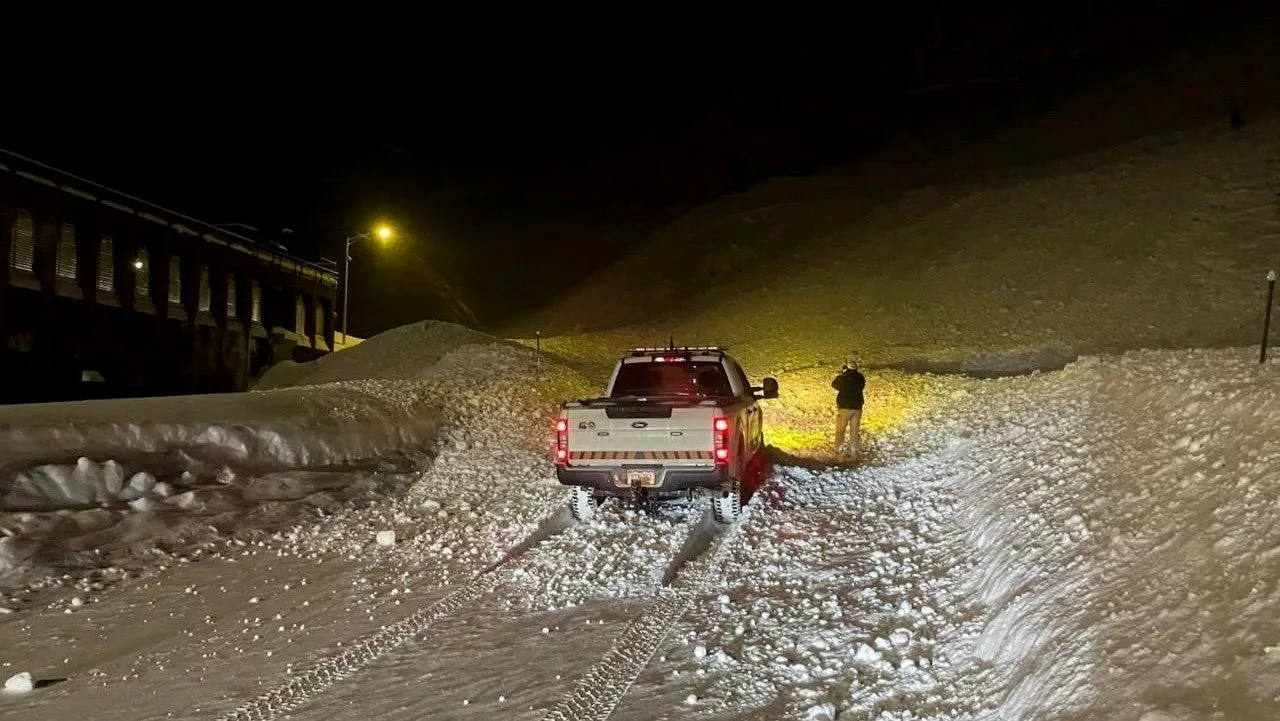
By Shannon Lukens.
CDOT photo: Avalanche debris, 10 ft. deep and 100 ft. wide, covering the Loop Road on the west side of the Eisenhower-Johnson Memorial Tunnel.
If you’re headed into the backcountry, be aware of avalanche conditions, especially after all of the heavy snow at the beginning of the week.
Colorado Avalanche Information Center says, “You can easily trigger an avalanche where intense westerly winds drifted snow about 3 feet deep or more on steep leeward slopes at all elevations. Avalanches in the most recent snow could easily be large enough to bury you. Look for and avoid steep drifted slopes below ridges, in gullies, or behind convex rollovers. Don’t forget steep open chutes in the trees or wind-affected grassy slopes at lower elevations are also suspect. If you see cracks shooting out in front of you in the snow or hear audible collapses, avoid steep slopes. Make conservative terrain choices and don’t travel on or below slopes less than about 35 degrees.”
Brian Lazar with the Colorado Avalanche Information Center says more snow is expected Thursday and Thursday night. 10-Day Weather Forecast
“This will continue to add fuel for wind-drifted snow and it’s going to be those wind-drifted slopes at the higher elevation, particularly in high rocky areas that remain the most dangerous.”
Check conditions at Colorado.gov/avalanche.
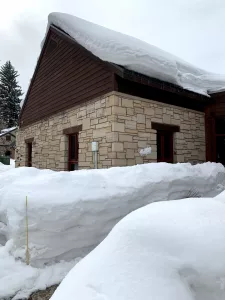
The heavy snow has presented another danger. The City of Steamboat Springs says be aware of how much snow is on your roof, and whether it can slide off and create a snowslide. Snow can drift over the edge of a roof, and ice can build up on structures. This snow and ice can break off and fall on someone who might be walking below. Be aware of children playing in those areas.
Colorado Department of Transportation is also reporting that the agency has completed avalanche mitigation along I-70 following multiple storms over the holiday weekend. Fifteen avalanche slide paths that reached the roadway along the I-70 Mountain Corridor have been safely cleared. The full press release is below the press release from the City of Steamboat Springs.
Press Release from the City of Steamboat Springs; Feb. 18, 2025.
Avalanche Awareness Continues Right to Front Door
Snow Accumulation on Roofs Brings Similar Precautions and Threats
STEAMBOAT SPRINGS, COLORADO-February 18, 2025-As the snow continues to pile up across Colorado and with the Steamboat Ski Resort seeing more than four feet stacking up this week, avalanche ratings from the Colorado Avalanche Information Center remain high for the Park Range with avalanche warnings in place in many areas. However, avalanche risks don’t stop in the backcountry but can run right up to your home.
“It might not appear to present much of a risk, but roofs can hold a significant amount of snow based on our building snow load guidelines and should carry the same snow awareness and respect,” commented Todd Carr, Routt County Regional Building Official. “Property owners should understand the risks and utilize proper safety precautions when dealing with snow on their roofs at all times.”
Property owners or managers should also be aware of the potential threat of snow slides, snow drifting over the roof edges, and ice build-up on structures. Temperature changes like what the valley has seen recently can cause snow or ice to break-off along edges and fall to the ground or onto your walking surfaces along your building.
“Always be mindful and avoid being under roofs with large snow loads and make sure children don’t play in these areas,” continued Carr. “Roof awareness should remain top of mind until the last flake is gone from our buildings in a few months.”
The Steamboat Springs area has been hit by a series of storms with fluctuating temperatures. The Steamboat Ski Resort has 232” for the season with March and April still to come. The Regional Building Department encourages evaluating roof conditions and taking appropriate steps to mitigate any potential risks that may exist. Risks vary depending upon building location, roof style, roof pitch, and type of roofing materials.
If snow mitigation is required, please take extra safety precautions when removing snow or ice from your roof as this process can be extremely dangerous. If the work is beyond your capability, there are local professionals that specialize in providing this service safely.
― Winter Travel ―
CDOT completes avalanche mitigation along I-70 following multiple storms over holiday weekend
15 avalanche slide paths reach roadway along I-70 Mountain Corridor and have been safely cleared
Clear Creek, Summit, Eagle Counties — Winter operations teams have safely triggered and cleared avalanche slide paths along I-70 through the mountain corridor following successive storms from last Thursday night through Tuesday morning. Measurements taken this morning on the summit of Vail Pass counted 28 inches of snow and 2.2 inches of snow water equivalent.
Those storms brought heavy accumulations of snow and high winds, which made for extreme conditions over long stretches of the Presidents Day weekend. With high volumes of car and truck travel, CDOT crews and law enforcement cleared vehicle spinouts, in addition to clearing roads of snow throughout the extended holiday weekend. Some periods of time saw short and intense bursts of snow that impeded visibility.
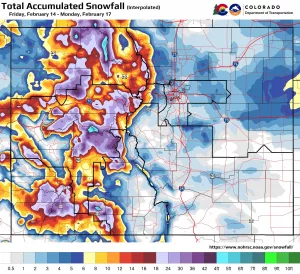
“Mother Nature did not take off for the holiday weekend. To the contrary, we saw some of the most intense snow totals of the season in the high country and multiple consecutive storms. Mountain Corridor ski resorts reported more than a foot and a half of fresh snow in 48 hours and more than four feet of snow in the past seven days. CDOT crews have been working around the clock to clear roads and mitigate avalanche risk, including a number of mitigation missions this morning. We remind drivers that conditions remain challenging. Please drive carefully through the tail end of this weather system, and watch out for snow plows and law enforcement who are working hard to keep the roads safe,” said CDOT Executive Director Shoshana Lew.
Every winter, CDOT and its sister agency, the Colorado Avalanche Information Center (CAIC), regularly monitor and control 278 of 522 known avalanche paths located above Colorado highways. These efforts help prevent avalanches from impacting motorists on the highways below. When there is a high risk of avalanche danger, CDOT will close the highway at the location of the avalanche path to conduct avalanche control. After the highway is closed, CDOT crews bring down the unstable snow from the mountain side and clear all snow and debris from the roadway before reopening the highway to traffic.
Four avalanche slide paths between the Eisenhower-Johnson Memorial Tunnel and the town of Silverthorne released debris onto the lanes of I-70 early this morning as crews performed mitigation missions. I-70 was briefly closed while these slides were triggered and crews cleared the road.
“The mitigation methods used in the early morning hours, before daylight, allowed our crews to work when traffic volumes are low,” said CDOT Director of Maintenance and Operations Shawn Smith. “This work is critical for keeping our roads safe, especially after the volume of snow we have seen over the past few days. We appreciate drivers’ patience as the team performs this important work of triggering avalanches and subsequent cleanup, which significantly reduces the risk of natural slides.”
“CAIC forecasters have been busy reading the snowpack for both backcountry users and Colorado highways,” said Ethan Greene, Director of the CAIC. “With avalanche danger rated as HIGH in the Northern Mountains, we’ve been diligent about communicating this danger to the public and working closely with CDOT maintenance crews.”
During a later morning mission, crews performed essential winter maintenance operations on Vail Pass, between Exit 180/ East Vail and Exit 195/ Copper Mountain, around 9 a.m. with five snowslides mitigation and one reaching the interstate lanes, as much as four feet deep and 175 feet in length.
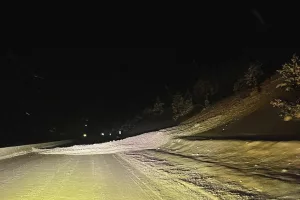
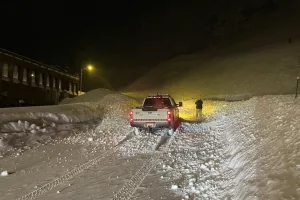

Visit COtrip.org for the latest information on road closures and conditions.
Visit the Colorado Avalanche Information Center’s website, colorado.gov/avalanche, for avalanche forecasts.
Download the COtrip App!
The free COtrip Planner mobile app was designed to meet the growing trend of information on mobile and tablet devices for the traveling public. The COtrip Planner app provides statewide, real-time traffic information, and works on mobile devices that operate on the iOS and Android platforms. Visit the Google Play Store (Android devices) or the Apple Store (iOS devices) to download!